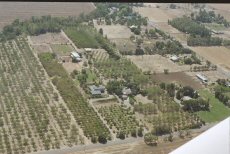
|
Rich |
This File Under Construction
Welcome to my page devoted to Rich Fields Farm.
(Yes, it is a play on words.)
Go to horticultural hotlist
last update: 29 February 2008
Rich Fields Farm
established 14 July 1993
Beyond my regular faculty duties, I own a small farm 4 miles from
Davis. Farm operations are split between me and
my wife. We
have a registered organic operation.
Our main crop is pistachios. We also grow many types of fruits from all regions
of the globe, several types of vegetables, other nut crops, and flowers (both
cutting and drying types). Below is a list of crops we are growing or trying
to grow.
The farm seems to require constant repairs! This
can sometimes be rewarding, sometimes frustrating, and always varying. I enjoy
planting, growing, and (especially) harvesting. I don't enjoy the pests or
weeds that try to be the world's toughest weeds. Total area is about 4 hectares.
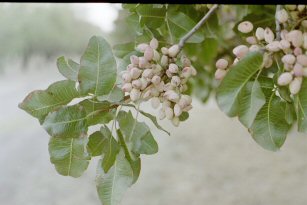
If you want details about our pistachio operation, they can
be found on a separate web page:
HERE. The site has
pictures of the harvesting, the trees, facts about our sales, etc.
There are links to Pistachio production websites, for
interesting recipes, nutrition facts, etc.
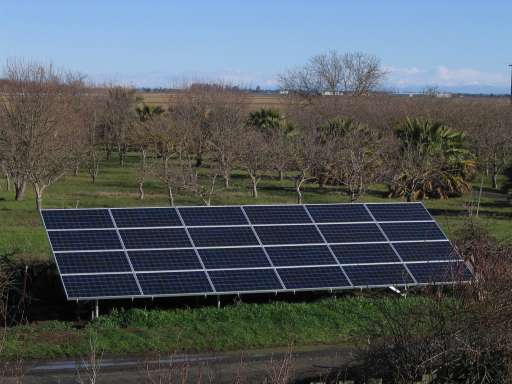
Making a commitment to reducing my family's greenhouse gas emissions, we
installed a 4kW system in early 2007. This system provides about 75% of the
electrical demand for our farmhouse and adjacent 'granny flat'. One can
monitor the activity at this website:
Grotjahn Residence PV system
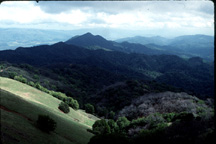 We live in Northern California,
where the countryside like this
sure is scenic... but the reality is that the area around our farm is quite flat
Elevation changes by 2 meters over 500 meters
from one end of our farm to the other.
Besides, steep hillsides like this would be
quite a challenge for driving a tractor. But, this type of countryside
is just a short drive away (Sonoma valley).
We live in Northern California,
where the countryside like this
sure is scenic... but the reality is that the area around our farm is quite flat
Elevation changes by 2 meters over 500 meters
from one end of our farm to the other.
Besides, steep hillsides like this would be
quite a challenge for driving a tractor. But, this type of countryside
is just a short drive away (Sonoma valley).
We do have a stream along one end of the farm. Sometimes it
is dry, sometimes it is half-full, and sometimes it flows with
amazing power! The mature trees along that stream attract nesting
hawks and owls. A drive along road 30 between our farm and road 98 is guaranteed
to find hawks. So we have our scenery.
Unfortunately, one of those owls decided to land on the power lines
feeding our well. The owl's last act was to create a brilliant
flash and a "buzzzt" sound at 5:14 am 30 July 1998. The bird not
only exploded, it cut power for several square miles.
Rich Fields Farm --- Greenhouse
Another stereo....
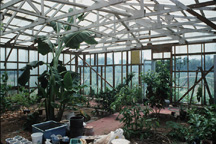
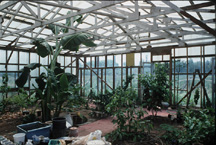
My greenhouse...a constant source of...(work? fun? ...?)
If you want to actually see this in stereo, I have a tutorial on
my stereo photography tutorial
home page.
Greenhouse notes
During the (record hot) summer of 1996, I raised the roof on my
greenhouse by 3 feet and replaced yellowed fibreglass with a clear
polycarbonate product from SPS inc. I highly recommend this product,
even at this early writing (10/96). First, it is easier to install
than LEXAN (no predrilling). It has a UV barrier coating on top (so
it comes with a 25 year guarantee). It has a dimpled surface
underneath (diffusing the sunlight and reducing leaf burning).
It also has a coating in the inside that allows condensation to flow
off, thus avoiding drips and reduced light from droplets.
It is designed to let in much more of the PAR (photosynthetically
active light) which has at least 3 consequences: some
plants are blooming for the first time, the plants are not as "leggy",
and the fruits are likely to be sweeter. Another benefit may be
greater pest resistance,too, since plants might
need more sunlight in order to
be able to manufacture insect-active products.
Plants that responded dramatically to the increased light levels
include: papaya, carambola, avocado, white sapote, and cherimoya.
I hope to include a few pictures in the next few weeks.
Update: a dozen years later, pictures are still has not loaded! Why? In a
word: kids! The greenhouse doesn't look much like the photo: all the plants have
filled the volume. As for the roof panels, 2 blew off in a storm on
4 January 2008; more than a decade shy of the 25 year guarantee.
Rich Fields Farm Crops
Planted, though not necessarily harvested!
Tree Fruits (outside)
- Apple (Black Arkansas, Gravenstein, Golden Delicious, Braeburn, Black
Astrachan, Pink Lady)
- Apricot (Blenheim, Harcot, Moorpark)
- Carob -- ceratonia siliqua (killed by January 07 freeze)
- Che ("Chinese" mulberry)
- Cherry (Royal Ann, Black Tartarian, Van, Bing)
- Cherry, Capulin
- Cherry, Cornelian (3 varieties)
- Fig (Kadota)
- Jujube (Li, Lang)
- Loquat (Big Jim?)
- Mulberry (Pakistan)
- Nectarine (Arctic glo, Desert Dawn, Liz's Late, Heavenly White)
- Olive (birdsown, mission, manzanillo)
- Paw Paw -- Asimina Triloba (8 varieties)
- Peach (Nectar, O'Henry, Desert Gold, Earlitreat, Fortyniner, Elberta
Q-1-8, Rio Oso Gem, Indian Free, Fairtime, White Heath, Carnival, El Dorado-mini)
- Pear (Bartlett, Comice)
- Pear, Asian (Hosui, 20th Century, Chojuro?, Shinko?)
- Persimmons (Izu, Fuyu)
- Plum (Mariposa, Bavay's Green Gage, Italian Prune)
- Pluot (Flavor King?)
- Pomegranate (6+ varieties)
- Quince (Smyrna?)
Citrus Family
- Blood Orange (Moro, Sanguinelli?)
- Navel (Robertson?)
- Valencia
- Kumquat
- Lemon (Eureka)
- Lime
- Grapefruit
- Mandarin (Owari Satsuma, Dancy)
- Tangelo
- White Sapote (SueBell)
Tropical Fruit
- Avocado ("Dwarf" (probably "little cado"), Mexicola, Bacon, Zutano, Gwen, Fuerte)
- Babaco (died :-( )
- Banana (Ice Cream, Mysore, Dwarf Blood)
- Carambola (Star fruit)
- Cherimoya (Pierce, White, RDG1)
- Dragon Fruit (Pitaya) -- Hylocereus and Selenicereus sp. (5 types)
- Guava (Red Indian)
- Litchi (Brewster -- struggling with our conditions)
- Longan -- Euphoria longana (Kohala, Diamond River)
- Mango (Mallika, Rosigold)
- Miracle Fruit -- Synsepalum dulcificum -- died! :-(
- Natal Plum (dwarf)
- Surinam Cherry (Victoria)
- **Ice Cream Bean (died, resprouted from seed, but has pest problems)
- Rose Apple -- died :-(
Nuts
- Almond (All-in-one, bird-sewn)
- Pecans (from seed)
- Pine (Digger)
- Pistachio (Kerman -- of course)
- Walnut (Chandler, Hartley, Black)
Palms
- Jelly Palm -- Butia edulis (edible)
- California Fan -- Washingonia Filifera (native, edible?)
- Guadeloupe Island Fan -- Brahea edulis (edible -- barely)
- Australian Fan (no fruit)
- Blue Guadeloupe Island Fan -- Brahea Armata
- Date (flowers, but no fruit)
- Chilean Wine Palm -- Jubea chilensis (struggling after wife ran mower over it,
check back in 100 years)
- Queen (no fruit)
Miscellaneous Fruits & Roots
- Bababerries
- Blackberries (marion, thornless, ollalie)
- Cape Gooseberry
- Goji berry
- Grapes (red seedless, thompson seedless, concord, 10+ other wine types)
- Melons (yellow, ambrosia, Hale's, winter queen, sugar bowl, sugar baby, etc)
- Osage orange (for Che rootstock)
Cut Flowers
- Roses (4 dozen hybrid teas, floribundas, and others)
- Iris (Japanese, Bearded, Rebloomers)
- Drying Flowers (Statice, Yarrow, Golden Drumstick)
Vegetables (varies from year to year)
- Tomato (Cherokee Purple, Sweet Isis, German Striped, Amish Paste, etc)
- Tomatillo
- Artichoke
- Corn (Silver Bullet, Silver Queen, How Sweet It Is, etc)
- Peppers (Numex Big Jim, N.Mex #6, N.Mex Joe E Parker, Yellow banana)
- Radishes (Icicle, sparkler, etc)
- Carrots (Nantes)
- Garlic (Early White, Late Red, Elephant, Red Toch)
- Cucumber (lemon boy, etc.)
- Squash
- Potatoes (Yellow finn, red Norlands, Russian banana, Yukon Gold, Cal-White, etc)
Other
- 3 little lambs (3/96). A year later they weigh > 100 lbs!!
In 1998 the largest weighs 200 lbs!
Crop News
- 1995 Pistachio harvest: 17,800 lbs wet weight!
The 1996 harvest was greatly reduced (about 1/7th the size of '95)
At least 4 factors caused the big drop in our harvest:
the warm winter (too little chill), the wet spring (during bloom),
a very heavy scaffold-adjusting pruning last winter, and the effects
of having a very heavy crop last year.
Of course, after hulling, drying, grading, & roasting, we
have a much smaller
amount of No. 1 nuts. I now keep information about the pistachio
production in a separate set of web pages that can be found
HERE.
Last year, the harvesting crew did not use the equipment properly resulting
in 1 sprikler valve being run over and 3 trees being girdled. (Remarkably,
those trees are still alive.)
- Of my tropicals: the "ice cream" banana had ripe fruit -- much
sweeter, and flavorful (delightfully complex) than store-bought. I let
the fruit bunch stay on the plant and only pick what turns yellow. I
stretched the harvest out over 4 late winter months. Those I sold at
a local farmers market went VERY fast!
The babaco produced 6 ripe fruit. The white sapote finally fruited.
What does a babaco taste like? It depends on the ripeness when picked.
Ripened off the plant, it tastes like a lemon without the tartness. Fully
ripened on the plant, the flavor is more complex, with other fruit
fragrances developing.
The Cherokee purple tomato did not set during temps > 95 F last year.
So, there was no fruit this summer. We hope to have fruit this fall.
Otherwise, I highly recommend this open-pollinated tomato.
An italian squash from Shepherds Seeds was once again:
highly productive, little bothered by
heat or virus, and had excellent taste (a hint of artichoke flavor). If you
try it, just make sure there are usable seeds in their packet!!
The winter queen melons were the most productive last year. This year
we have a good, but late, crop forming. They also lasted a long
time (i.e. until Christmas). The sugar bowl melons were the prettiest: yellow
dots on dark green -- looks like the night sky -- is it actually the heirloom
"moon & stars"?
The melons, corn, peppers and most other vegetables I planted did very
well where I brought loamy soil up from the creek in order to amend our heavy
clay. Soil management can have a big impact on productivity. Ditto for
potatoes this year (as might be obvious for a root crop).
Rich Fields Farm Animals
Production
- Wool Sheep (3 black, 3 white, all females)
- Nigerian Dairy goats (2 females)

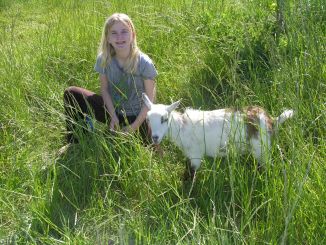
Pets
- 3-legged house cat (striped)
- Mixed breed dog (part Aus. Shepherd))
Boarded
- horses (varies, usually either 2 or 3)
- Nigerian Dairy goat (wethers)
Wild :-)
- various raptors: hawks & owls
- various pest birds (crows, jays, magpies, mainly)
- possums, racoons, and skunks -- ahhh life in the country
- lots and lots of ground squirrels
.
Quick Hotlist
yes, MORE stereo images...


A list of favorite internet addresses (just for starters!)
WWW Virtual Library organized by an extensive list of subjects.
Horticultural Sites:
A site for
plant information
set up by Ohio State Univ.
California Rare Fruit Growers internet site.
Fruit and nut
crop
information internet site at UC Davis.
Backyard orchard information internet site at UC Davis.
Fruit growth
charts Dave Wilson Nursery.
integrated pest management internet site at UC Davis.
Fairs
internet site of tropical fruit information (Univ. Florida ag. info. res.
service).
Edible Landscaping
Database internet site
A site for
gardening magazines
such as Sunset & Southern Living, set up by Time Inc.
Oregon State University
National
Plant Germplasm Site including access to list of internet resources.
A site showing:
plant pest images
set up by Prof. H. Leith, here at UCD.
A site showing:
plant foliar disease images
also set up by Prof. H. Leith, here at UCD.
Return to my homepage
Return to UCD Atmospheric Science
home page.




 We live in Northern California,
where the countryside like this
sure is scenic... but the reality is that the area around our farm is quite flat
Elevation changes by 2 meters over 500 meters
from one end of our farm to the other.
Besides, steep hillsides like this would be
quite a challenge for driving a tractor. But, this type of countryside
is just a short drive away (Sonoma valley).
We live in Northern California,
where the countryside like this
sure is scenic... but the reality is that the area around our farm is quite flat
Elevation changes by 2 meters over 500 meters
from one end of our farm to the other.
Besides, steep hillsides like this would be
quite a challenge for driving a tractor. But, this type of countryside
is just a short drive away (Sonoma valley).





